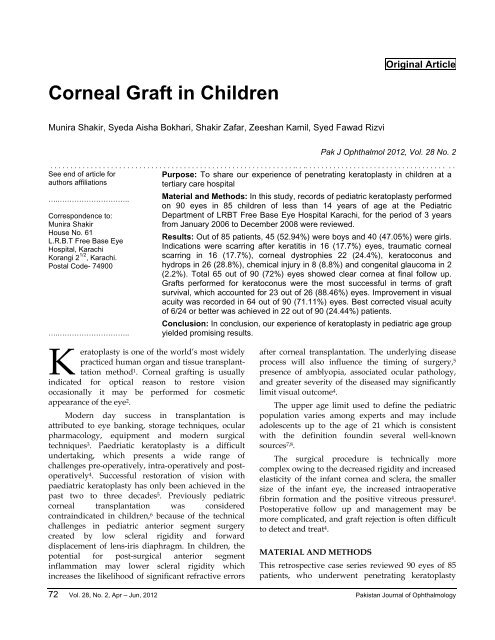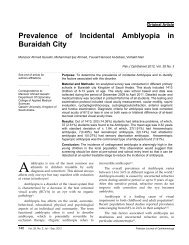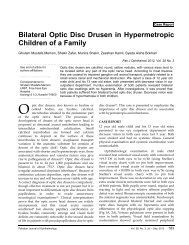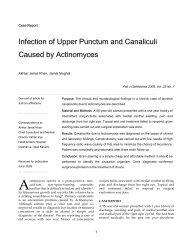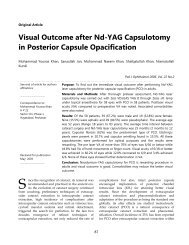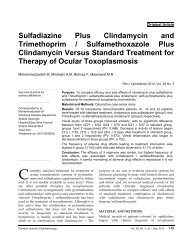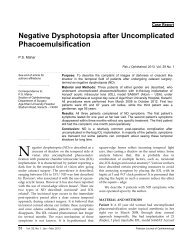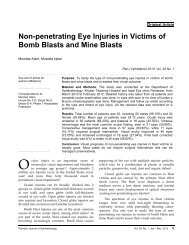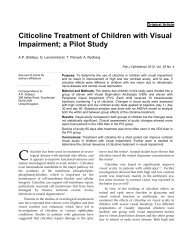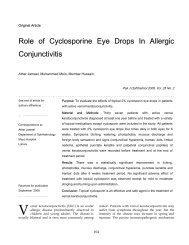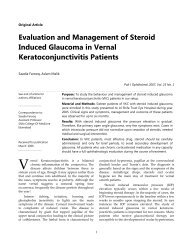Corneal Graft in Children - Pakistan Journal of Ophthalmology
Corneal Graft in Children - Pakistan Journal of Ophthalmology
Corneal Graft in Children - Pakistan Journal of Ophthalmology
Create successful ePaper yourself
Turn your PDF publications into a flip-book with our unique Google optimized e-Paper software.
Orig<strong>in</strong>al Article<strong>Corneal</strong> <strong>Graft</strong> <strong>in</strong> <strong>Children</strong>Munira Shakir, Syeda Aisha Bokhari, Shakir Zafar, Zeeshan Kamil, Syed Fawad RizviPak J Ophthalmol 2012, Vol. 28 No. 2. . . . . . . . . . . . . . . . . . . . . . . . . . . . . . . . . . . . . . . . . . . . . . . . . . . . . . . . . . . . .. . .. . . . . . . . . . . . . . . . . . . . . . . . . . . . . . . . . . . . .See end <strong>of</strong> article forPurpose: To share our experience <strong>of</strong> penetrat<strong>in</strong>g keratoplasty <strong>in</strong> children at aauthors affiliationstertiary care hospital…..………………………..Correspondence to:Munira ShakirHouse No. 61L.R.B.T Free Base EyeHospital, KarachiKorangi 2 1/2 , Karachi.Postal Code- 74900…..………………………..Material and Methods: In this study, records <strong>of</strong> pediatric keratoplasty performedon 90 eyes <strong>in</strong> 85 children <strong>of</strong> less than 14 years <strong>of</strong> age at the PediatricDepartment <strong>of</strong> LRBT Free Base Eye Hospital Karachi, for the period <strong>of</strong> 3 yearsfrom January 2006 to December 2008 were reviewed.Results: Out <strong>of</strong> 85 patients, 45 (52.94%) were boys and 40 (47.05%) were girls.Indications were scarr<strong>in</strong>g after keratitis <strong>in</strong> 16 (17.7%) eyes, traumatic cornealscarr<strong>in</strong>g <strong>in</strong> 16 (17.7%), corneal dystrophies 22 (24.4%), keratoconus andhydrops <strong>in</strong> 26 (28.8%), chemical <strong>in</strong>jury <strong>in</strong> 8 (8.8%) and congenital glaucoma <strong>in</strong> 2(2.2%). Total 65 out <strong>of</strong> 90 (72%) eyes showed clear cornea at f<strong>in</strong>al follow up.<strong>Graft</strong>s performed for keratoconus were the most successful <strong>in</strong> terms <strong>of</strong> graftsurvival, which accounted for 23 out <strong>of</strong> 26 (88.46%) eyes. Improvement <strong>in</strong> visualacuity was recorded <strong>in</strong> 64 out <strong>of</strong> 90 (71.11%) eyes. Best corrected visual acuity<strong>of</strong> 6/24 or better was achieved <strong>in</strong> 22 out <strong>of</strong> 90 (24.44%) patients.Conclusion: In conclusion, our experience <strong>of</strong> keratoplasty <strong>in</strong> pediatric age groupyielded promis<strong>in</strong>g results.Keratoplasty is one <strong>of</strong> the world’s most widelypracticed human organ and tissue transplanttationmethod 1 . <strong>Corneal</strong> graft<strong>in</strong>g is usually<strong>in</strong>dicated for optical reason to restore visionoccasionally it may be performed for cosmeticappearance <strong>of</strong> the eye 2 .Modern day success <strong>in</strong> transplantation isattributed to eye bank<strong>in</strong>g, storage techniques, ocularpharmacology, equipment and modern surgicaltechniques 3 . Paedriatic keratoplasty is a difficultundertak<strong>in</strong>g, which presents a wide range <strong>of</strong>challenges pre-operatively, <strong>in</strong>tra-operatively and postoperatively4 . Successful restoration <strong>of</strong> vision withpaediatric keratoplasty has only been achieved <strong>in</strong> thepast two to three decades 5 . Previously pediatriccorneal transplantation was consideredcontra<strong>in</strong>dicated <strong>in</strong> children, 6 because <strong>of</strong> the technicalchallenges <strong>in</strong> pediatric anterior segment surgerycreated by low scleral rigidity and forwarddisplacement <strong>of</strong> lens-iris diaphragm. In children, thepotential for post-surgical anterior segment<strong>in</strong>flammation may lower scleral rigidity which<strong>in</strong>creases the likelihood <strong>of</strong> significant refractive errorsafter corneal transplantation. The underly<strong>in</strong>g diseaseprocess will also <strong>in</strong>fluence the tim<strong>in</strong>g <strong>of</strong> surgery, 5presence <strong>of</strong> amblyopia, associated ocular pathology,and greater severity <strong>of</strong> the diseased may significantlylimit visual outcome 4 .The upper age limit used to def<strong>in</strong>e the pediatricpopulation varies among experts and may <strong>in</strong>cludeadolescents up to the age <strong>of</strong> 21 which is consistentwith the def<strong>in</strong>ition found<strong>in</strong> several well-knownsources 7,8 .The surgical procedure is technically morecomplex ow<strong>in</strong>g to the decreased rigidity and <strong>in</strong>creasedelasticity <strong>of</strong> the <strong>in</strong>fant cornea and sclera, the smallersize <strong>of</strong> the <strong>in</strong>fant eye, the <strong>in</strong>creased <strong>in</strong>traoperativefibr<strong>in</strong> formation and the positive vitreous pressure 4 .Postoperative follow up and management may bemore complicated, and graft rejection is <strong>of</strong>ten difficultto detect and treat 4 .MATERIAL AND METHODSThis retrospective case series reviewed 90 eyes <strong>of</strong> 85patients, who underwent penetrat<strong>in</strong>g keratoplasty72 Vol. 28, No. 2, Apr – Jun, 2012 <strong>Pakistan</strong> <strong>Journal</strong> <strong>of</strong> <strong>Ophthalmology</strong>
Munira Shakir, et al.from January 2006 to December 2008 <strong>in</strong> PediatricDepartment LRBT Free Base Eye Hospital, Karachi.Out <strong>of</strong> 85 patients, 45 (52.94%) were boys and 40Fig. 4:Fig. 1Fig. 2:(47.05%) were girls. Inclusion criteria <strong>in</strong>cludedpatients with age rang<strong>in</strong>g from 6 to 14 years with nosex predeliction; patients diagnosed with traumaticcorneal scarr<strong>in</strong>g,corneal dystropies, keratoconus andhydrops, chemical <strong>in</strong>jury and congenital glaucoma.Exclusion criteria <strong>in</strong>cluded comb<strong>in</strong>ed non-cornealprocedures,herpetic keratitis, patients with age below6 years and patients who were lost to followup.M<strong>in</strong>imum follow up was 6 months while meanfollow up was 15 months.Preoperatively all patientsunderwent a complete ocular exam<strong>in</strong>ation which<strong>in</strong>cluded visual acuity assessment, <strong>in</strong>traocularpressure measurement, slit lamp and dilated fundusexam<strong>in</strong>ation, A and B scan if needed. At the end <strong>of</strong>surgery all patients received systemic and topicalsteroids to decrease <strong>in</strong>flammatory reaction. Topicalcycloplegics, steroids and antibiotic eye drops wereadm<strong>in</strong>istered postoperatively. Follow up exam<strong>in</strong>ationswere performed consist<strong>in</strong>g <strong>of</strong> visual acuity assessmentand slit-lamp exam<strong>in</strong>ation, <strong>in</strong>traocular pressure,fundus exam<strong>in</strong>ation and if needed ultrasonicexam<strong>in</strong>ations. In the eyes with amblyopia, occlusion oratrop<strong>in</strong>ization <strong>of</strong> the good eye was conductedpostoperatively. Early optical correction withspectacles or contact lenses was pursued asaggressively as possible.Data was analysed on SPSS (version 13).Frequency and percentages were calculated for age,gender, best corrected visual acuity, graft survival andfailure. Chi-square test and Fisher exact test wereapplied to calculate p-value and p< 0.005 was taken asstatistically significant.Fig. 3:SURGICAL TECHNIQUEAll penetrat<strong>in</strong>g keratoplasty surgeries were done bythe same surgeon, under general anesthesia. Standard<strong>Pakistan</strong> <strong>Journal</strong> <strong>of</strong> <strong>Ophthalmology</strong> Vol. 28, No. 2, Apr – Jun, 2012 73
<strong>Corneal</strong> <strong>Graft</strong> <strong>in</strong> <strong>Children</strong>Table 1: <strong>Graft</strong> failure and survival <strong>in</strong> different groups and their statistical significance (p
Munira Shakir, et al.for the poorer prognosis are technically difficultsurgery and irreversible amblyopia 9 .Penetrat<strong>in</strong>g keratoplasty <strong>in</strong> children is generallyconsidered a high risk procedure, because surgery <strong>in</strong> asmall eye can lead to a sclera collapse. Moreover, theiris is more adherent and the vitreous more tenacious<strong>in</strong> children than <strong>in</strong> adults 9 . Improved results havebeen attributed <strong>in</strong> part to the advantages <strong>in</strong> surgicaltechnique, improved donor-storage media anddevelopment <strong>of</strong> viscoelastics. Therefore, the rate <strong>of</strong><strong>in</strong>traoperative complications has been significantlydecl<strong>in</strong>ed. 9 Despite all the developments, the <strong>in</strong>cidence<strong>of</strong> <strong>in</strong>flammatory reaction and immunological rejectionis still significant. The prognosis for graft clarity <strong>in</strong>children is poorer because <strong>of</strong> the high bioreactivityand heal<strong>in</strong>g potential <strong>of</strong> a child’s eye, which is veryrapid and causes sutures to loosen quickly 10 .In this series overall graft survival at the end <strong>of</strong>follow up was 65 out <strong>of</strong> 90 (72.22%). <strong>Graft</strong> performedfor keratoconus were most successful <strong>in</strong> terms <strong>of</strong> graftsurvival which was seen <strong>in</strong> 23 out <strong>of</strong> 26 (88.46%).Gabric N et all reported 64% graft survival <strong>in</strong> theirseries <strong>of</strong> corneal transplantation, with best prognosis<strong>in</strong> graft for keratoconus and congenital dystrophy 11 .Overall 5-year graft survival was 82%, withkeratoconus and corneal dystrophy as reported byRehman I et all 12 . Dandona L et al also reported 46.5%graft survival <strong>in</strong> their study, with highest rate <strong>of</strong> graftsurvival for keratoconus 13 . Patel HY, documented 82%graft survival at the end <strong>of</strong> one year 14 .In this study postoperative visual acuityimprovement was recorded <strong>in</strong> 64 out <strong>of</strong> 90 (71.11%)eyes. Visual acuity improvement ranged fromcount<strong>in</strong>g f<strong>in</strong>ger to 6/12 partial. 22 out <strong>of</strong> 90 (24.44%)patients achieved a best corrected visual acuity <strong>of</strong> 6/24or better. McClellan et al reported improvement <strong>in</strong>visual acuity better than 6/60 <strong>in</strong> only 14% <strong>of</strong> cases 15 .Xu-Jia H et al reported improvement <strong>in</strong> visual acuityby 6/18 or better <strong>in</strong> 13% <strong>of</strong> cases 1 .CONCLUSIONIn this study 72.22% eyes showed clear cornea postoperativelywith improvement <strong>in</strong> visual acuity seen <strong>in</strong>71.11%. Most successful results were seen <strong>in</strong> eyes withkeratoconus <strong>in</strong> which graft survival was observed <strong>in</strong>88.46% cases. Keep<strong>in</strong>g the above f<strong>in</strong>d<strong>in</strong>gs <strong>in</strong> view, weconclude that keratoplasy is a safe and effectivetreatment <strong>in</strong> pediatric age-group. Further cl<strong>in</strong>ical trialsare required to establish these f<strong>in</strong>d<strong>in</strong>gs.Author’s affiliationDr. Munira ShakirConsultant OphthalmologistL.R.B.T Free Base Eye Hospital, KarachiKorangi 2 1/2 , Karachi.Postal Code- 74900Dr. Syeda Aisha BokhariAssociate OphthalmologistL.R.B.T Free Base Eye Hospital, KarachiKorangi 2 1/2 , Karachi.Postal Code- 74900Dr. Shakir ZafarConsultant OphthalmologistL.R.B.T Free Base Eye Hospital, KarachiKorangi 2 1/2 , Karachi.Postal Code- 74900Dr. Zeeshan KamilAssociate OphthalmologistL.R.B.T Free Base Eye Hospital, KarachiKorangi 2 1/2 , KarachiPostal Code- 74900Dr. Syed Fawad RizviChief Consultant OphthalmologistL.R.B.T Free Base Eye Hospital, KarachiKorangi 21/2, KarachiPostal Code- 74900REFERENCE1. Xu HJ, Jiang XJ, Jie SM, et al. Pediatric penetrat<strong>in</strong>gkeratoplasty <strong>in</strong> shanghai: a retrospective multiple centre studyfrom 2003 to 2007. Ch<strong>in</strong> Med J. 2008; 121: 1911-4.2. <strong>Corneal</strong> and refractive surgery. In: Kanski JJ. Cl<strong>in</strong>icalophthalmology a systemic approach. London: ButterworthHe<strong>in</strong>eman: 2011. 239-50.3. Mc Neill JI. Pentrat<strong>in</strong>g keratoplasty: preoperativeconsiderations, <strong>in</strong>dications and outcomes. In Krachker JH,Mannis MJ, Holland EJ (eds). Mosby: Cornea, St Louis. 1997; 3:1551-61.4. Vajpayee RB, Ramu M, Panda A et al. Oversized grafts <strong>in</strong>children. <strong>Ophthalmology</strong>. 1999; 106: 829-32.5. Pediatric penentrat<strong>in</strong>g keratoplasty. In: Krachmer JH, MannisMJ, Holland EJ, Cornea: surgery <strong>of</strong> the cornea and conjunctiva.St Louis: Mosby Year Book. 1997; 1731-56.6. Leigh AG. <strong>Corneal</strong> graft<strong>in</strong>g. Br J Cl<strong>in</strong> Pract. 1958; 12: 329.7. Berham RE, Kliegman R, Arv<strong>in</strong> AM, et al. Nelson Textbook <strong>of</strong>pediatrics, 15 th ed, Philadelphia: W.B Saunders company; 1996.8. Rudolph AM. Rudolph’s Pediatrics, 21 st Ed. NY: McGraw-Hill;2002.9. Stult<strong>in</strong>g RD. Penetrat<strong>in</strong>g keratoplasty <strong>in</strong> children. In:Brightbill, F.S., (Ed.): <strong>Corneal</strong> surgery. (Mosby St. Louis,Missouri, 1993).10. Dana, MR, Schaumberg DA, Moyes AL, et al. Gomes JAP,<strong>Ophthalmology</strong>. 1997; 104: 1580.<strong>Pakistan</strong> <strong>Journal</strong> <strong>of</strong> <strong>Ophthalmology</strong> Vol. 28, No. 2, Apr – Jun, 2012 75
<strong>Corneal</strong> <strong>Graft</strong> <strong>in</strong> <strong>Children</strong>11. Gabric N, Dekaris I, Vojnikovic B, et al. <strong>Corneal</strong>transplantation <strong>in</strong> children. Coll Antropol 2001; 25: 17-22.12. Rahman I, Carley F, Hillarby C, et al. Penetrat<strong>in</strong>gkeratoplasty: <strong>in</strong>dications, outcomes, and complications. Eye.2009; 23: 1288-94.13. Dandona L, Naduvilath T, Janarthanan M, et al. Survivalanalysis and visual outcome <strong>in</strong> a large series <strong>of</strong> cornealtransplants <strong>in</strong> <strong>in</strong>dia.14. Patel HY, Ormonde S, Brookes NH, et al. The <strong>in</strong>dications andoutcome <strong>of</strong> paediatric corneal transplantation <strong>in</strong> New Zealand:1991-2003. Br J Ophthalmol. 2005: 89: 404-8.15. McClellan K, Lai T, Grigg J, et al. Penetrat<strong>in</strong>g keratoplasty <strong>in</strong>children: visual and graft outcome. Br J Ophthalmol. 2003; 87:1212-4.76 Vol. 28, No. 2, Apr – Jun, 2012 <strong>Pakistan</strong> <strong>Journal</strong> <strong>of</strong> <strong>Ophthalmology</strong>


